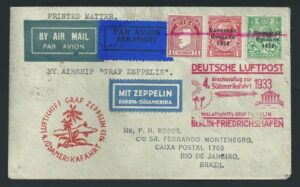Cover collecting did not begin at the same time as did stamp collecting. Philately had its start in earn est about 1860, and, really, until about 1910, cover collecting was something collectors did when they didn’t have the time to wash the stamps they needed for their collections off the envelopes on which they had bought them (this is why so many earlier stamps are so much rarer on cover than off). In a few cases, such as Pony Express covers or Civil War Patriotics, much of the collecting interest had to do with the cachet on the envelope and the usage that the cover received (rather than the stamp) so that there were a few early cover savers. But serious postal history collecting had to wait until the efforts of Henry Gibson, Sr. Gibson was the first collector who looked for rare usages of stamps on covers and assembled a major collection that was sold in the early part of the twentieth century. It was his financial success as a cover collector that began the impetus for the second great wave of cover collecting that began about 1930.
est about 1860, and, really, until about 1910, cover collecting was something collectors did when they didn’t have the time to wash the stamps they needed for their collections off the envelopes on which they had bought them (this is why so many earlier stamps are so much rarer on cover than off). In a few cases, such as Pony Express covers or Civil War Patriotics, much of the collecting interest had to do with the cachet on the envelope and the usage that the cover received (rather than the stamp) so that there were a few early cover savers. But serious postal history collecting had to wait until the efforts of Henry Gibson, Sr. Gibson was the first collector who looked for rare usages of stamps on covers and assembled a major collection that was sold in the early part of the twentieth century. It was his financial success as a cover collector that began the impetus for the second great wave of cover collecting that began about 1930.
 Covers come in two broad types – the first, as collected by Gibson and postal historians today – are stamps on envelopes or unstamped envelopes that went through the post for some commercial, military, or social purpose, for which the mail carriage was incidental to the user’s real end, which was the delivery of the message. In other words, these covers are non-philatelic. The second broad category of cover collecting, which began around 1920, are covers that were designed, even before posting, for collectors. They include First Day Covers, Airmail covers, Zeppelin Covers, Naval Covers, and many other types that fit this broad designation.
Covers come in two broad types – the first, as collected by Gibson and postal historians today – are stamps on envelopes or unstamped envelopes that went through the post for some commercial, military, or social purpose, for which the mail carriage was incidental to the user’s real end, which was the delivery of the message. In other words, these covers are non-philatelic. The second broad category of cover collecting, which began around 1920, are covers that were designed, even before posting, for collectors. They include First Day Covers, Airmail covers, Zeppelin Covers, Naval Covers, and many other types that fit this broad designation.
Philatelic covers began to be very popular about 1930. Collecting items of this type gave collectors a great deal to do at a very low cost, both prime considerations in an era with little money (it was the Great Depression) and few new issues. Philatelic covers increased in
